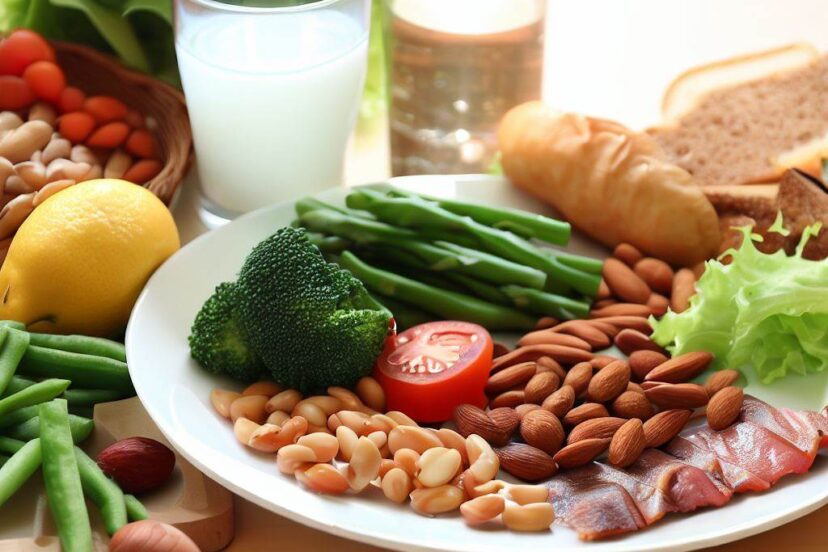Elimination Diet Meal Plan: Unlocking Dietary Wellness
*We may earn a commission for purchases made using our links. Please see our disclosure to learn more.
Elimination Diet Meal Plan: Your Guide to Identifying Food Sensitivities
An elimination diet meal plan is a strategy used to identify foods that an individual may be intolerant or sensitive to. It involves removing certain foods from the diet for a period of time then systematically reintroducing them while monitoring for symptoms. This process can help pinpoint specific dietary triggers that may contribute to issues like digestive distress, allergies, skin irritations, or other health problems.

My own experience with elimination diets confirms that they require careful planning and adherence to see results. It’s crucial to prepare a variety of meals using foods that are considered low-risk for causing reactions. For example, fresh or frozen vegetables, lean proteins, and certain whole grains often form the base of the diet during the elimination phase. A well-structured meal plan ensures that I maintain a balanced diet while avoiding the foods that could potentially cause discomfort or adverse reactions.
Understanding Elimination Diets

In my practice, I’ve found that an elimination diet can be a powerful tool to understand how certain foods affect individuals, particularly when it comes to digestive issues and chronic inflammation.
What Is an Elimination Diet?
An elimination diet involves removing specific foods or food groups from my diet that are suspected of causing allergic reactions or sensitivities. By methodically cutting these foods out and then reintroducing them one by one, I can closely monitor and identify any adverse symptoms or changes in my well-being. Common trigger foods that are often eliminated include dairy, gluten, soy, eggs, nuts, fish, and certain nightshades.
Identifying Common Symptoms
While on an elimination diet, I watch for a variety of symptoms that may suggest a food intolerance or sensitivity. These can include gastrointestinal issues such as bloating, gas, diarrhea, or irritable bowel syndrome (IBS); skin reactions like eczema; respiratory issues; or even general fatigue and headaches. Identifying and then avoiding the foods causing these symptoms can significantly ease inflammation and improve my overall health.
Designing Your Elimination Diet Meal Plan

When I set out to design my elimination diet meal plan, the foundation involved identifying foods potentially causing issues and then systematically removing them from my diet. It’s crucial to approach this process methodically while ensuring adequate nutrient intake to prevent nutritional deficiencies.
Elimination Diet Meal Plan: Consulting with a Registered Dietitian
I always recommend consulting with a registered dietitian before starting an elimination diet meal plan. A registered dietitian’s expertise is invaluable in helping to pinpoint which foods I might need to eliminate. They ensure that any foods removed are substituted with alternatives to maintain a balanced nutrient intake. A dietitian helps me design a meal plan that doesn’t compromise my overall health. Additionally, with a professional’s help, I can keep a detailed food journal, which is an essential step in monitoring my body’s reactions to different foods and assists in identifying any correlations between food intake and symptoms. By collaborating closely with a healthcare professional, I not only increase the effectiveness of the diet in identifying triggers for any adverse symptoms but also protect my health during the process.
Potential Food Triggers and Alternatives

In my experience with elimination diets, certain foods are more likely to trigger sensitivities in individuals. Below, I’ll detail common culprits and provide alternative suggestions to tailor your meal plan effectively.
Common Allergens and Intolerances
Often, the main culprits of food sensitivities and allergies include:
- Dairy: This category includes milk and products derived from milk, which contain lactose and casein that can cause issues for lactose intolerant or allergic individuals.
- Gluten: Found in wheat, barley, and rye, gluten can cause problems for those with celiac disease or gluten sensitivity.
- Nuts: Tree nuts and peanuts frequently trigger allergic reactions.
- Soy: Soybeans and soy products can cause reactions in some people.
- Eggs: Particularly the proteins in egg whites are known allergens.
- Corn: It is common in many processed foods and can cause adverse reactions.
- FODMAPs: These are specific types of carbohydrates that can cause symptoms in people with irritable bowel syndrome (IBS).
These food groups encompass a variety of proteins, fats, and carbohydrates that are integral to many diets, which is why identifying alternatives is so important.
Suggested Alternatives for the Elimination Diet Meal Plan
To navigate around these common allergens and intolerances, consider the following swaps:
- Dairy Alternatives
- Milk Alternatives: Almond milk, coconut milk, oat milk
- Cheese Alternatives: Nutritional yeast, vegan cheeses made from nuts or soy
- Gluten-Free Grains
- Wheat Alternatives: Quinoa, rice, millet, buckwheat
- Gluten-Free Products: Look for gluten-free bread, pasta, and baking mixes
- Nut-Free Options
- Replace peanut and tree nuts with seeds such as sunflower or pumpkin seeds
- Nut-free butters: Tahini (sesame seed paste), sunflower seed butter
- Soy Substitutes
- Protein Alternatives: Legumes like lentils and chickpeas, quinoa, and hemp seeds
- Soy Sauce Alternative: Coconut aminos, tamari (gluten-free)
- Egg Replacements
- Baking: Chia seeds or flaxseed meal mixed with water, mashed banana, applesauce
- Cooking: Silken tofu, vegan egg replacement products
- Corn Alternative
- Grain Alternatives: Rice, quinoa, and tapioca can replace corn in many recipes
- Low-FODMAP Choices
- Avoid high-FODMAP fruits like apples and pears, opting for berries and oranges instead
- Choose low-FODMAP vegetables and grains, and limit legumes
By carefully selecting alternatives to common triggers, I can enjoy a diverse and nutritionally balanced diet while identifying any foods that may cause discomfort or allergic reactions.
The Process of Reintroducing Foods

After an elimination diet, my key focus is on carefully reintroducing foods to identify any potential triggers for allergies or intolerances. This phase is critical as it helps me understand how my body responds to each food individually.
The Reintroduction Phase of the Elimination Diet Meal Plan
During the reintroduction phase, I start with foods least likely to cause a reaction. I introduce one food group at a time and consume it in small amounts. Typically, I perform this step every 3-7 days, starting with a half teaspoon of the food and gradually increasing the portion if no symptoms occur.
- Day 1: Half teaspoon of the food, observe for 15 minutes
- Day 1: If no reaction, one full teaspoon, then observe for another 15 minutes
- Day 1: If still no reaction, 1.5 teaspoons, followed by a 2-3 hour observation period
- Day 3-7: If no adverse reactions are noted, I eat a normal portion and monitor symptoms for the next 3-7 days
If I observe any signs of food allergies or intolerances, such as inflammation or chronic symptoms, I do not proceed further and eliminate the food once again.
Monitoring Symptoms Post-Reintroduction
I maintain a detailed food and symptom diary to track my body’s reactions post-reintroduction. Any symptoms, including subtle changes in digestion, energy levels, or mood, are recorded. If symptoms do appear, it indicates a likely sensitivity or intolerance and warrants removing the food from my diet again to assess if symptoms improve.
- Symptom Diary: Note the time of food consumption and any symptoms for at least 7 days post-reintroduction.
- Detailed Observation: Pay attention to digestive discomfort, skin changes, or any other inflammation-related symptoms.
- Consistency: I’m consistent with logging information to ensure accurate identification of food triggers.
The goal is to have a clear understanding of which foods cause discomfort, allowing me to tailor my diet for optimal health.
Special Considerations for Long-Term Health

When implementing an Elimination Diet Meal Plan for long-term health, I focus on ensuring nutritional balance while accommodating food sensitivities and managing any chronic conditions through dietary choices.
Balancing Nutrition and Food Sensitivities
In my experience, the challenge with elimination diets is maintaining a balanced intake of nutrients while identifying and avoiding triggers for food sensitivities. If, for example, I advise cutting out dairy to test for lactose intolerance, it’s imperative to replace the lost sources of calcium and vitamin D with alternatives to prevent deficiencies.
- Nutrients commonly at risk:
- Calcium
- Vitamin D
- Fiber
- Recommended substitutes:
- Calcium-fortified plant milk for standard dairy milk
- Vitamin D supplements if sunlight exposure is insufficient
- High-fiber fruits, vegetables, and grains in place of wheat if a gluten sensitivity such as celiac disease is suspected
Managing Chronic Conditions via Diet
For chronic conditions such as inflammatory bowel disease (IBD) or irritable bowel syndrome (IBS), I advocate for a deliberate, well-monitored approach. Here, the Elimination Diet can be particularly beneficial to identify foods that exacerbate symptoms.
- Gut microbiome: A diverse, healthy gut microbiome can influence overall gut health, potentially alleviating IBS symptoms. Hence, even when removing certain foods, I ensure the inclusion of prebiotic and probiotic-rich foods where possible.
Chronic Condition Management Strategies:
- IBD: Avoid individual triggers and focus on anti-inflammatory foods
- IBS: Identify and exclude foods that lead to bloating and discomfort; soluble fiber may help
Through careful planning and possibly collaboration with a health professional, such as a registered dietitian, I make sure that anyone following an Elimination Diet for extended periods can do so without compromising their long-term health or nutritional needs.
Frequently Asked Questions
I’ve gathered some of the most common inquiries about elimination diets to help guide you through the process, ensure accuracy, and provide straightforward meal planning advice.
1. What foods should be avoided during an elimination diet?
During an elimination diet, I generally avoid foods that are common allergens such as dairy, gluten, soy, eggs, nuts, corn, sugar, and shellfish. I also look out for processed foods and artificial additives which could trigger symptoms.
2. How do I plan my meals for a 30-day elimination diet?
I plan my meals by first identifying safe foods that do not trigger symptoms. My meal planning involves a variety of whole, unprocessed foods from all the food groups that are allowed. I ensure there’s a balance of proteins, vegetables, fruits, and safe grains every day.
3. What are some vegetarian options for an elimination diet meal plan?
For a vegetarian elimination diet, I focus on plant-based proteins like quinoa, lentils, and certain seeds that are not restricted. I also include a variety of fruits, vegetables, and gluten-free grains, as long as they are not identified triggers.
4. Can you provide an example of a 21-day elimination diet schedule?
Here’s an example for a 21-day schedule: In week one, I remove all potential allergens from my diet. In weeks two and three, I introduce one food group at a time every 48-72 hours, monitoring for symptoms. I keep detailed notes to track the results.
5. How is an 8-food group elimination diet structured?
An 8-food group elimination diet involves removing the top eight allergens: milk, eggs, fish, shellfish, tree nuts, peanuts, wheat, and soybeans. I start by eliminating these foods for a set period and then systematically reintroduce them one at a time to monitor for reactions.




